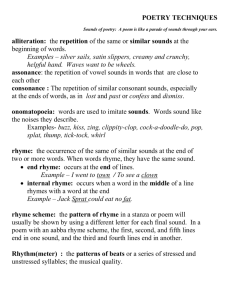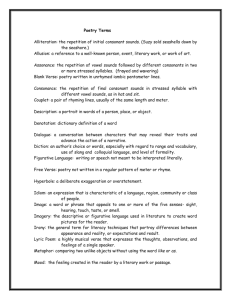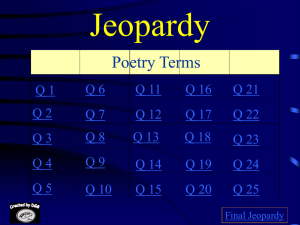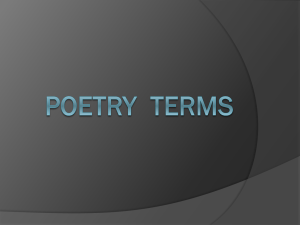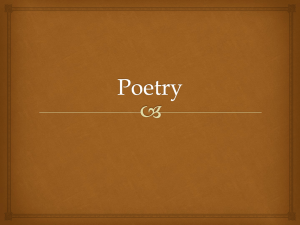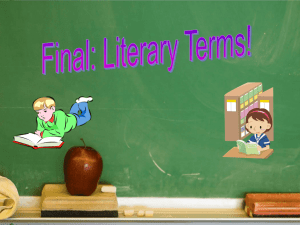Poetry Terms
advertisement
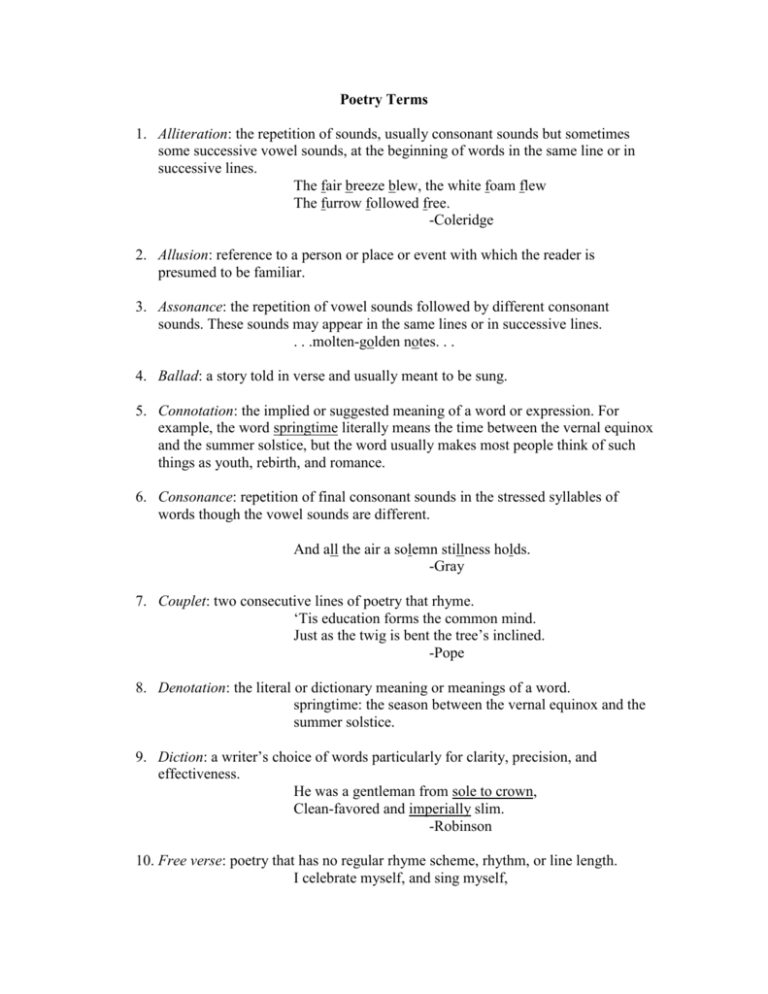
Poetry Terms 1. Alliteration: the repetition of sounds, usually consonant sounds but sometimes some successive vowel sounds, at the beginning of words in the same line or in successive lines. The fair breeze blew, the white foam flew The furrow followed free. -Coleridge 2. Allusion: reference to a person or place or event with which the reader is presumed to be familiar. 3. Assonance: the repetition of vowel sounds followed by different consonant sounds. These sounds may appear in the same lines or in successive lines. . . .molten-golden notes. . . 4. Ballad: a story told in verse and usually meant to be sung. 5. Connotation: the implied or suggested meaning of a word or expression. For example, the word springtime literally means the time between the vernal equinox and the summer solstice, but the word usually makes most people think of such things as youth, rebirth, and romance. 6. Consonance: repetition of final consonant sounds in the stressed syllables of words though the vowel sounds are different. And all the air a solemn stillness holds. -Gray 7. Couplet: two consecutive lines of poetry that rhyme. „Tis education forms the common mind. Just as the twig is bent the tree‟s inclined. -Pope 8. Denotation: the literal or dictionary meaning or meanings of a word. springtime: the season between the vernal equinox and the summer solstice. 9. Diction: a writer‟s choice of words particularly for clarity, precision, and effectiveness. He was a gentleman from sole to crown, Clean-favored and imperially slim. -Robinson 10. Free verse: poetry that has no regular rhyme scheme, rhythm, or line length. I celebrate myself, and sing myself, And what I assume you shall assume, For every atom belonging to me belongs to you. -Whitman 11. Hyperbole: a figure of speech employing obvious exaggeration or over-statement for special effect. And I will luve thee still, my dear, Till a‟ the seas gang dry. -Burns 12. Internal Rhyme: the rhyming of the end word with a word in the middle of the line. I bring fresh showers for the thirsting flowers. 13. Lyric: a poem, usually a short one, that expresses a speaker‟s personal thoughts or feelings. 14. Metaphor: a figure of speech that makes a comparison between two things that are basically dissimilar. The train is a needle plunging into the fabric of the night. 15. Metonymy: the substitution of a term naming an object closely associated with the word in mind for the word itself. “The crown” = the king “The White House” = the President 16. Narrative Poem: a poem that tells a story. 17. Onomatopoeia: the use of words which in their pronunciation suggest their meaning. It cracked and growled, and roared and howled Like noises in a swound. -Coleridge 18. Personification: a figure of speech in which something non-human is given human qualities. A narrow wind complains all day How someone treated him. -Dickinson 19. Refrain: a group of words, a line, or a group of lines repeated throughout a poem, usually at the end of each stanza. . . . Quoth the raven, “Nevermore.” -Poe 20. Repetition: a literary technique in which words or phrases are repeated at regular intervals to secure emphasis. . . .silver bells. . . . . .golden bells. . . . . . alarm bells. . . . . .iron bells. . . . . . bells, bells, bells, bells. . . -Poe 21. Rhyme: repetition of the same (or similar) sounds or sounds at the end of words. Usually, in poetry, rhyming means the ending of two or more lines with words that sound alike. I never saw a moor. (a) I never saw the sea. (b) Yet I know how the heather looks, (c) And what a wave must be. (b) -Dickinson 22. Rhyme Scheme: the pattern of rhyme in a poem. A rhyme scheme uses a different letter of the alphabet to stand for each different rhyming sound. (see rhyme) 23. Scansion: The indication of foot divisions and accents in metrical verse. 24. Simile: a figure of speech in which the comparison between two unlike things is expressed directly, usually by means of like or as. What happens to a dream deferred? Does it dry up like a raisin in the sun? -Hughes 25. Stanza: a group of lines of verses treated as a unit and separated from other units by a space. 26. Symbol: any object, person, place, or action that has a meaning in itself and that also stands for something larger than itself such as a quality, an attitude, or a value. A rose is often a symbol of love and beauty; a skull if often a symbol of death; spring and winter often symbolize youth and old age. 27. Synecdoche: a form of metaphor which in mentioning a part signifies the whole or the whole signifies the part. “all hands on deck” = all sailors; “counting heads” = counting whole people 28. Imagery: The representation through language of sense experience visual imagery: an image that occurs in the minds eye auditory imagery: an image which represents a sound olfactory imagery: an image which represents a smell gustatory imagery: an image which represents a taste tactile imagery: an image which represents touch 29. Verbal Irony: Saying the opposite of what one means. In a sense, irony is the discrepancy between what is said and what is meant. 30. Meter: The pattern created in a particular poem by the repetition of a basic grouping of accented syllables. Each grouping is called a foot. There are four groupings in English metrical poetry: da dum, dum da, da da dum, and dum da da. A line of metrical poetry can consist of any number of feet. A chart of metrical feet: (dum is louder than da; thus it receives the accent.) Sound Da Dum Dum Da Da Da Dum Dum Da Da Example return turning resurrect curious Name of Foot iamb trochee anapest dactyl Name of Meter iambic trochaic anapestic dactylic The basic foot of a line of metrical poetry should be described by one of the four names listed in the chart above. The length of the line (the number of feet in the line) should be described according to the following: one foot, monometer two feet, diameter three feet, trimeter four feet, tetrameter five feet, pentameter six feet, hexameter seven feet, heptameter eight feet, octameter A line of five feet is said to be in pentameter. A line which consists of five iambs is said to be in iambic pentameter.


